Introduction
Thank you for the opportunity to be here with you tonight.
With 2011 rapidly coming to an end, I thought I might take stock of what has happened over the year, both globally and domestically, and muse a little about what lies in store for the year, and years, ahead.
A year in retrospect
2011 has been a tumultuous year.
Were I to have been standing here this time last year, I would have said something like:
The Australian economy is in a strong position … real GDP is now growing at around its trend rate … The global economy has recovered from recession faster than expected, but at different speeds across regions … Financial market conditions have improved since the sharp increase in market volatility and stress experienced in mid-2010 when the European sovereign debt crisis reached its peak.1
MYEFO 2010-11
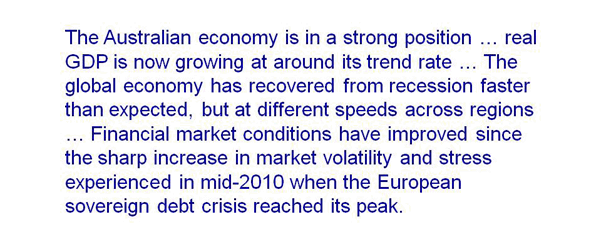
Source: Part 1, 2010-11 Mid-Year Economic and Fiscal Outlook.
In fact, a barrage of events, either unanticipated or occurring more rapidly than expected, has battered both the global and Australian economies.
Who would have thought standing here last December that we were shortly to see a series of tremendous and devastating natural disasters. Floods and cyclones in Australia; the triple calamity of an earthquake, tsunami and nuclear accident in Japan; and a second devastating earthquake in New Zealand.
These natural disasters have wreaked immense damage on people and communities in all these regions.
And they have also had significant implications for the Australian economy.
The deadly floods in Queensland saw the tragic loss of 35 of our fellow Australians and, along with Cyclone Yasi, disrupted countless other lives, with the loss of houses, jobs and community infrastructure. They disrupted coal exports, while agricultural production was also hit hard, with the resulting supply shortages leading to temporary, but significant, increases in some product prices and to headline inflation.
The events in Japan, a key export market for our commodities, impacted on the closely integrated global supply chains of vehicles and high-end manufactures. Indeed, the loss of production in Japan was a key factor in the 12 per cent plunge in US light vehicle sales over April to June, with similar impacts being seen in Australia — clearly evidence of globalisation at work.
Combined these natural disasters subtracted around ¾ of a percentage point from Australia's economic growth in 2010-11.
These events also meant that the Australian economy, and to some extent the global economy, entered 2011 on a less stable footing than anticipated, although the global and domestic outlooks still seemed broadly positive.
This stability has been questioned a number of times this year, including in part by the major geo-political event of the year – the "Arab Spring". This reawakening of the Arab peoples has seen the overthrow of governments in Tunisia, Egypt, Libya, a transition of power in Yemen, serious challenges to the authority of others in the region, and what looks to be virtual civil war in Syria.
It is too early to tell how this will all turn out, but these are events that I suspect will have long-term geo-political and, possibly, economic implications.
But what of the global recovery?
Well, it was dramatically undermined by a series of events emanating in the North Atlantic.
To be frank, Europe spent 2011 lurching between economic catastrophe and mere disaster. The world watched morbidly fascinated as a fundamental mismatch between underlying competiveness and fiscal policies dragged one Euro-zone country after another into crisis, recognising that the integration of global banking systems increasingly risked turning Europe's slow-motion train wreck into a global problem.
And while we all knew that the US faced considerable medium-term fiscal challenges, how many of us expected a decision around raising the debt cap for the US Government would reach the brink of pushing the US into default?
Or that this would result in the unprecedented loss of its AAA credit rating?
As a result of these factors, and the inability or unwillingness of political institutions in the affected countries to craft effective responses, at the end of 2012 the Mid Year Economic and Fiscal Outlook (MYEFO) describes the short term global outlook as follows:
International growth prospects have weakened markedly since Budget and the risks to global stability from the European sovereign debt crisis have intensified … The deterioration in global conditions has contributed to a weaker near-term outlook for the Australian economy than at Budget, with forecast gross domestic product (GDP) and employment growth both revised lower. Conditions are also expected to remain uneven, with the weaker global economy, the high Australian dollar and cautious household spending behaviour creating significant challenges for some sectors.2
MYEFO 2011-12
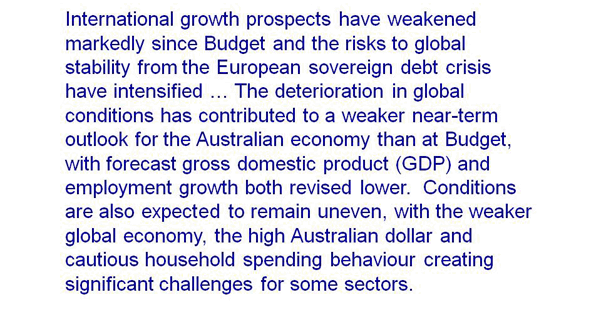
Source: Part 1, 2011-12 Mid-Year Economic and Fiscal Outlook.
Despite this, Australia remains among the best placed of all the world's advanced economies to weather the fallout from these global developments. But we have been significantly affected and we cannot expect to be immune if things deteriorate further.
MYEFO saw our forecasts downgraded from Budget, with economic growth lowered by ¾ of a percentage point in 2011-12 and by ½ of a percentage point in 2012-13. We have seen forecast revenue fall by some $20 billion over the forward estimates, meaning that in 2012-13 alone our revenue forecasts are some $10 billion lower than we anticipated prior to the GFC.
At the same time, our economic growth is still likely to be around trend, underlying inflation is firmly in the middle of the RBA's target band, and unemployment remains close to the NAIRU.3
Australian banks remain well placed to handle the ongoing funding market pressures emanating from Europe. Our four major banks remain among the most profitable and well capitalised in the world. Indeed, according to Standard and Poor's, Australia's four major banks remain amongst the safest in the world, with only one bank globally rated higher.
A decade in prospect
In describing the start of the next decade, most attention is devoted to the continuing fallout from the North Atlantic. So, what does 2012 and beyond hold?
Let's start with Europe.
In early 2011, ongoing concerns a
bout Greece's debt led to fears of a disorderly Greek debt default and adversely impacted confidence in the region. Coupled with 'slippage' in the Greek IMF/EU program in May 2011, this resulted in markets once again becoming highly stressed. These developments weighed on confidence and economic growth in the region.
In Greece, the need to meet agreed targets under the IMF/EU program despite dramatic falls in forecast GDP, led to even more dramatic fiscal tightening. This 'vicious cycle' was widely seen as unsustainable without further intervention.
And the fate of Ireland and Greece was increasingly being projected onto other Eurozone countries as the year progressed.
In mid-2011, EU leaders agreed to increase the effective size of the region's emergency bailout fund, the European Financial Stability Facility (EFSF), to combat the crisis. However, delays in its implementation, together with a lack of detail, on top of deteriorating growth prospects and fears of contagion through interlinked banking systems, resulted in significant market scepticism and led to the credit ratings of the sovereigns underwriting the guarantees being threatened —adding to greater uncertainty, and a further escalation in the crisis.
As the year progressed, economic prospects in Europe continued to worsen and market confidence in political institutions' capacity to develop credible responses continued to decline. This manifested in different ways in different countries. For example the previous Italian government's perceived 'foot dragging' when it came to implementing credible reforms, saw Italian bond yields climb to around 7½ per cent. Given Italy's sizable debt (gross debt is 120 per cent of GDP) and deteriorating outlook, this led to concerns that it would be difficult for Italy to service its debt, should yields remain at these elevated levels.
Chart 1: Euro area sovereign debt spreads
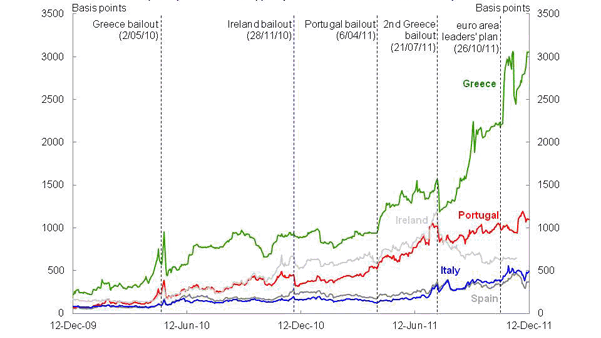
Note: The data series for 10-year Irish government bonds was discontinued by Thomson Reuters on 23 November 2011, with Thomson Reuters stating that there are no eligible 10-year government bonds that can be used to underlie the 10-year point on the Irish benchmark curve. Source: Thomson Reuters.
The 26 October Leaders Summit attempted to achieve three key objectives — place Greek sovereign debt on a sustainable footing, minimise contagion to other euro area sovereigns by increasing the firepower of the EFSF, and restore confidence in Europe's banking sector by increasing banks' capital requirements.
However, markets remained sceptical over the measures. In particular, questions remained over the details, implementation and whether the commitment existed to deal with underlying problems associated with both high sovereign debt and weak growth.
The recent announcement (9 December) of moves towards more fiscal integration is to be welcomed, but repeats the same process, with little detail feeding even more heightened market scepticism. Moreover, while the measures announced may be a good step forward in addressing medium to longer term issues, they are not perceived by markets as dealing with the immediate problems facing the region4.
Before leaving Europe, let me return to again to Greece and the vicious circle referred to earlier. Historically what has tended to occur is that in response to the crisis, the troubled sovereign implements even harsher austerity measures. Greece is a case in point.
Chart 2: Greek GDP and fiscal adjustment
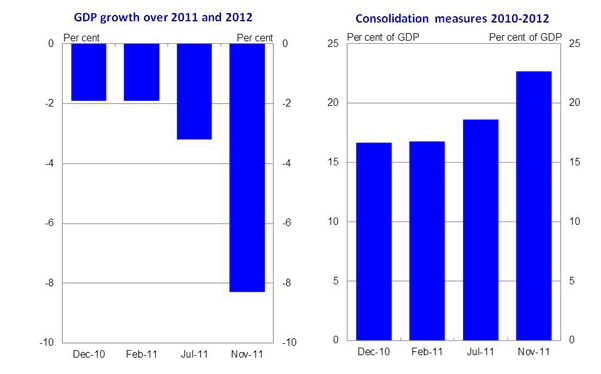
As this chart shows, each subsequent review of its program has meant even greater fiscal consolidation and corresponding lower rates of economic growth. To achieve agreed targets under the IMF/EU program requires even greater austerity. That is, fiscal policy is pro-cyclical without any other actions to boost growth.
Source: European Commission, Reserve Bank of Australia and Treasury.
Given the delays in crafting a Euro-wide credible policy response, and the fiscal contractions now underway in many Euro-zone members, Europe will almost certainly return to recession next year, with the potential for it to be deep and drawn out.
On a more positive note, let's now turn to the US.
Compared to only 6 months ago, the US economic recovery is looking in far better shape.
The first half of 2011 saw a US economy hit by a confluence of events that acted to seriously impede the growth of the world's largest economy.
Poor weather in early 2011 depressed tentative growth in the construction sector, which was followed by ongoing supply-chain effects of the Japanese tsunami that seriously affected the US manufacturing sector, and US exports.
Together, this culminated in combined GDP growth of only 0.4 per cent in the first half of 2011. In addition, downward revisions to US GDP meant that at even by the June quarter 2011, the US economy had still not completely recovered from the 2008-09 recession.
Confidence in the recovery was not assisted by the Congressional debt ceiling debate, which took the US to the brink of default.
Since then, however, the fortunes of the US economy appear to have turned, with consumer confidence rising and domestic demand contributing to a relatively robust September quarter GDP growth of 0.5 per cent. That said, this remains a very unusual recovery, with GDP only now back to pre-GFC levels.
Chart 3: US recessions
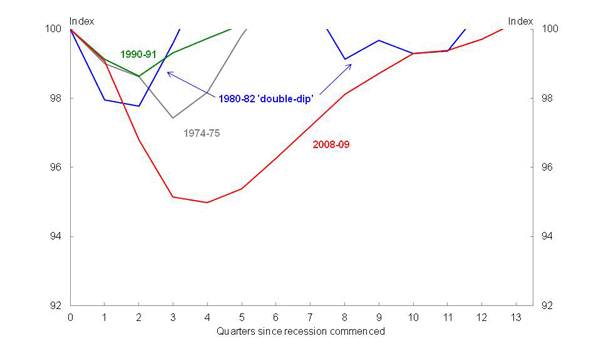
And the US labour market remains anaemic, with employment still nearly 5 per cent below its peak.
Source: US Bureau of Economic Analysis and Thomson Reuters.
Chart 4: US labour market
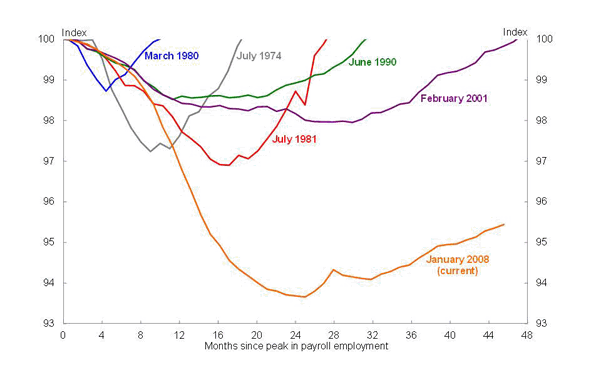
Source: US Bureau of Labor Statistics and Thomson Reuters
The US housing market remains equally depressed, with an estimated excess supply of housing to that would take around 8 months to clear, at current sales rates, and with persistently low house prices acting to weigh down new home construction.
Chart 5: US house prices
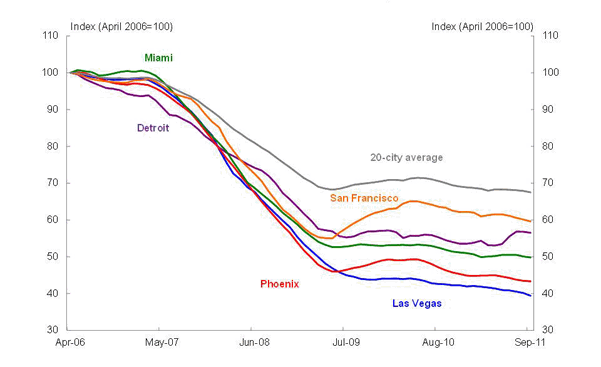
Source: S&P Case – Shiller and Thomson Reuters.
That said, the US economy is now on the path to a recovery — albeit a slow, and tentative one.
However, the US' public balance sheet remains in a work in progress. The failure of the Congressional 'Supercommittee', tasked with finding US$1.2 trillion in budget savings has now triggered automatic spending cuts. These could reduce GDP growth by up to ¾ of a percentage point in financial year 2013, a potentially significant shock to what is likely to be a still modest recovery.
Back to Australia
Developments in 2011 in the North Atlantic have emphasised the importance of good public finances. They also highlight how critical is a focus on underlying competitiveness to generate sustainable growth — and that this requires credible medium-term macroeconomic policy frameworks and structural flexibility.
As I noted earlier, developments globally have, and will continue to have, impacts on Australia. Perhaps the most marked impact has been on the budget, particularly through the
write down in the Commonwealth's revenue estimates.
In total, revenue over 2008-09 to 2012-13 is expected to be $141 billion less than we expected at the 2008-09 Budget, as a result of the GFC, natural disasters and now the growth effects of the European crisis.
Chart 6: Tax receipt estimates
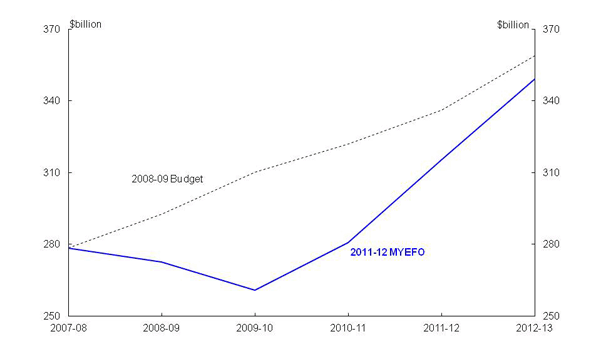
Source: Treasury
While the impact was less than was initially feared, around $110 billion of the revenue downgrade can be directly explained by the GFC.
Over the past 18 months, natural disasters and the ongoing problems in Europe have caused revenue to be revised down again, by around $30 billion over the years to 2012-13. While the economy will recover in time, the revenue is permanently lost, meaning our debt levels are higher than otherwise.
The weaker domestic growth outlook also means that setting fiscal policy to be consistent with the Government's medium-term fiscal strategy will continually involve tough decisions. Recall that the Government's fiscal strategy includes achieving budget surpluses, on average, over the medium term and keeping taxation as a share of GDP, on average, below the level for 2007-08.
The weak outlook for revenue is expected to continue beyond the forward estimates; as a result tax receipts are expected to stay below 2007-08 levels as a share of GDP for much of this decade.
The Government has also committed to restrain annual real growth in spending growth to 2 per cent on average until a surplus of over 1 per cent of GDP is achieved. As Chart 7 illustrates, to achieve the projected surpluses, spending as a share of the economy will have to be slightly lower on average, than the average between 2000-01 and the start of the GFC.
Chart 7: Government spending and revenue
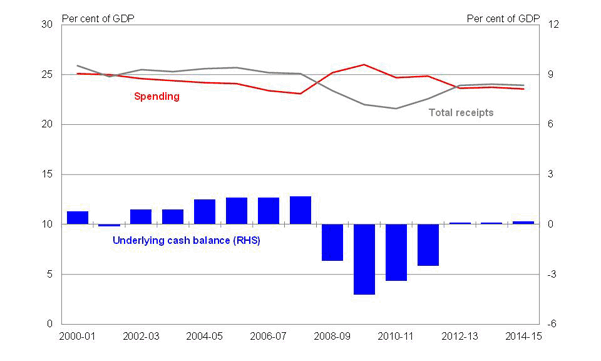
Source: Treasury
While it is our own performance that ultimately matters, Australia's fiscal indicators also suggest we are well placed compared to other advanced economies. The Government is planning on returning the budget to surplus ahead of the major advanced economies.
Further, the average net debt position of the major advanced economies (G7) is projected to reach in excess of 90 per cent of GDP in 2016, more than 10 times higher than the expected peak in Australia's net debt of 8.9 per cent of GDP.
While our actual position is healthy, and markedly so in comparison to other advanced economies, this is not a cause for complacency — we will need continued focus on hard decisions to deliver these outcomes and to maintain fiscal credibility and sustainable public finances.
And while fiscal consolidation remains a priority, Australia also needs to continue pursuing an economic reform agenda which will assist the Australian economy adjust to global shocks, and generate a sustainable base from which to create and boost wealth and living standards over the next decade.
This means tackling the decline in our productivity performance in order to expand our growth potential, offset the impacts of ageing and allow us to respond to the global economic transformation from west to east that is underway.
The decade in prospect: the continued rise of Asia
While 2011 saw multiple shocks to the global economy, we also continued to witness a more longer-term transformation in the global economy with the rise of the emerging market economies - particularly of China and India. There has been considerable attention this year on the impacts of structural change arising from this global transformation on the Australian economy, typically relating to the impacts of the higher exchange rate threatening the viability of business models, particularly in the manufacturing sector.
But the exchange rate story is only one part of the broader structural adjustment process unfolding in the economy. While it may appear to some that this story of structural adjustment has only begun in 2011, these changes are in part an acceleration of underlying shifts in the makeup of the economy that have been underway for some time.
In 2006, my predecessor, Ken Henry, spoke publicly on several occasions about the impact of the re-emergence of China into the global economy would have on the structure of the Australian economy. A substantial demand for mineral commodities by China and other emerging economies leads to a terms of trade boom, providing a price signal, re-allocating resources towards the mining sector and away from import-competing sectors, with the volume of trade expanding for both resource exports and imports of manufactures. As was noted at the time, these were expected to be long-run trends, reshaping the Australian economy for many decades.5
As we all know, these factors have played out in just this manner over recent years.
These developments led to much thinking about the appropriate policy frameworks and settings needed to respond to both the associated challenges and opportunities.6 Themes of a flexible economy, promoting sustainable growth and boosting productivity are firmly a part of this.
A flexible exchange rate is important for macroeconomic stability and also in spreading the benefits from the boom.
More broadly, a more flexible economy helps allocate resources more effectively and can lead to better overall macroeconomic outcomes. Take the performance of the labour market for example. We have seen evidence that despite the geographic concentration of the mining sector, and the emergence of the multi-speed economy, the dispersion of unemployment across regions has actually narrowed in recent years. We suspect this outcome owes much to efforts to improve labour market flexibility over many years.
Chart 8: Regional distribution of unemployment
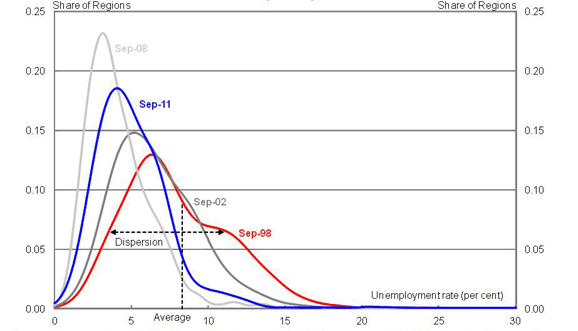
Note: Statistical Local Areas (SLAs) are standard small geographic regions in Australia. There are around 1,400 SLAs under the 2006 classifications. As the size of the labour force for SLAs varies from less than 100 to around 100,000, figures in the chart use employment outcomes weighted by labour force size. Regional distributions are smoothed using Gaussian kernel density estimation. For presentational clarity, distributions are over-smoothed with windows of 1, 1, ½ and 3/4 selected for Sep-1998, Sep-2002, Sep-2008 and Sep-2011.
Source: DEEWR Small Area Labour Market database and Treasury.
Chart 9: Unemployment across the economy
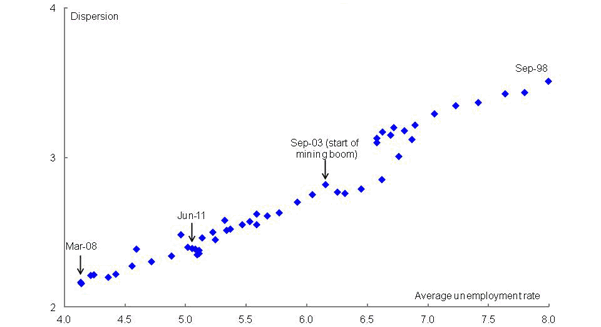
Note: Each point on the scatter plot represents the weighted average and weighted standard deviation of regional unemployment for a particular quarter between Sep-1998 and Jun-2011. The weighted average unemployment rates for all SLAs differ slightly from those estimated in ABS 6202.0
Source: DEEWR Small Area Labour Market database and Treasury.
While the first stage of China and India's development manifests itself in Australia's eyes as demand for our natural resources, the story is richer and the opportunities to come are greater still — but so too are the challenges for Australia.
As they seek to shift millions of their citizens out of poverty, becoming more urbanised and build the cities, infrastructure and amenities that we in advanced economies take for granted, emerg
ing economy living standards will rise and the size of the middle class will grow significantly.
In 2009 there were around half a billion middle class consumers in the Asia-Pacific region. By 2020 it is expected that this figure will increase by an astonishing 1.7 billion people. If this scenario eventuates, this region will have more middle class consumers than the rest of the world combined, and China will have the world's single largest middle class market in dollar terms.
Chart 10: Projections of the global middle class by region
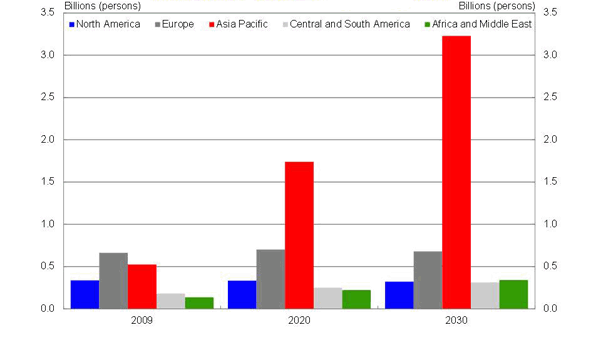
Source: Kharas, H and Gertz G, 2010, ‘The New Global Middle Class: A Cross-Over from West to East’ in C Li (ed), China’s Emerging Middle Class: Beyond Economic Transformation, Washington, DC, Brookings Institution Press.
As the size of this Asian middle class expands and incomes rise, they will exhibit consumption patterns akin to advanced economies — this creates a massive potential market for our key knowledge-based exports like education and high-end manufacturing, as well as tourism. As living standards improve, purchasing power rises and food consumption patterns change, so we can also expect to see growing demand for agricultural and soft commodities as new members of the middle class have greater opportunities for a more protein-rich diet.
No one should be under the illusion that the growth paths of emerging economies, whether China or any other country, will be smooth and uninterrupted — there will be cycles of growth, but we anticipate these will be around a strong rising trend when looked at in decadal terms.
In the case of China, a key test will be how the government manages the need for greater reliance on more market-like policy instruments and how it further integrates with the existing global economic architecture (or in fact re-shapes it).
With the economic centre of gravity shifting with the re-emergence of Asia, there are consequential, and profound, implications for international geopolitical relationships, the result of which is a more multi-polar distribution of influence.
This means Australia will operate in a global and regional environment where leading powers have very different political systems and operating assumptions, with few current signs of convergence, and differing views on the provision of public goods (such as economic stability and environmental commons). Moreover, Australia will be operating in the historically unique environment where its primary economic and security relationships do not coincide.
While the growth of China, India and other emerging economies will continue the diffusion of global influence, the major developed economies, including the US, Japan and parts of Europe, will continue to have a strong influence on the global economy through their technological leadership, contribution to world growth, accumulated wealth and prominence in world financial markets. However, structural weakness in these economies, in the form of significant financial and fiscal imbalances and, in parts of Europe, weak international competitiveness, will take many years to play out. Much of the next decade is therefore, likely to be characterised by slow rates of growth in the key developed economies, with additional macroeconomic volatility arising from what has traditionally been thought of as a more stable part of the world economy.
In this world of weaker growth in advanced economies, the importance of the emerging economies rises even further, and faster.
But because China has grown so quickly, it has not yet really found its feet as the world's second largest economy and is not really sure what sort of leader it should be.
The rise of Asia — in particular the China story —brings with it a number of complexities which are equally as important to comprehend as the opportunities I have discussed.
Highlighting this point, the Prime Minister recently commissioned a White Paper on Australia in the Asian Century, led by Dr Henry. Understanding that the growth and change in Asia will have immense global as well as regional implications, it will be important to take a broad perspective on what this all means for Australia and how we can prepare ourselves to reap the benefits and manage any risks.
Conclusion
To conclude, we have seen a number of significant events, some still unfolding, which were largely inconceivable this time last year. And other long-lived transformations have, if anything, accelerated. Given the near-term global economic outlook remains uncertain, we may find ourselves saying the same thing this time next year — though at least we could say we predicted that!
The Australian economy has not been immune from these events.
However, Australia can take some comfort from its starting position. We are located in the fastest growing region in the global economy with a number of opportunities likely to present themselves over the next decade. Equally, the flexibility of our economy and our medium-term oriented policy frameworks have assisted Australia manage the impacts from external volatility.
The policies that have stood us in good stead in the current volatility will also provide a good foundation for the policies we need to pursue to reap the opportunities in prospect over the next decade and beyond.
Conclusion
To conclude, we have seen a number of significant events, some still unfolding, which were largely inconceivable this time last year. And other long-lived transformations have, if anything, accelerated. Given the near-term global economic outlook remains uncertain, we may find ourselves saying the same thing this time next year — though at least we could say we predicted that!
The Australian economy has not been immune from these events.
However, Australia can take some comfort from its starting position. We are located in the fastest growing region in the global economy with a number of opportunities likely to present themselves over the next decade. Equally, the flexibility of our economy and our medium-term oriented policy frameworks have assisted Australia manage the impacts from external volatility.
The policies that have stood us in good stead in the current volatility will also provide a good foundation for the policies we need to pursue to reap the opportunities in prospect over the next decade and beyond.
1 Part 1, 2010-11 Mid-Year Economic and Fiscal Outlook.
2 Part 1, 2011-12 Mid-Year Economic and Fiscal Outlook.
3 The NAIRU, or non-accelerating inflation rate of unemployment, refers to the level of unemployment below which generally results in increases in the rate of inflation.
4 Note also that the 9 December moves are not a step toward full fiscal union but are a tightening of the rules of how individual countries should respond to rising fiscal deficits. As such, on the detail available they seem to encourage pro-cyclical fiscal policies.
5 Henry, K. (2006), ‘The Fiscal and Economic Outlook’, Address to the Australian Business Economists.
6 For instance, see Statement 4 in Budget Paper No.1 in both 2010-11 and 2011-12 Budgets.